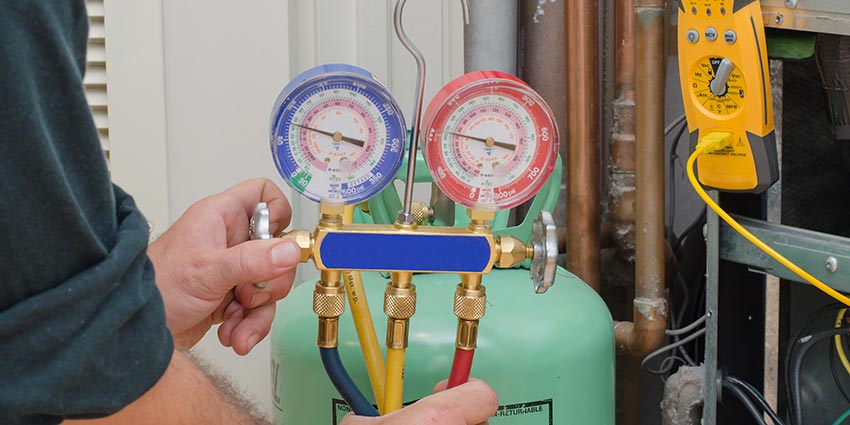|
When a certified HVAC technician is dispatched to your home to complete an AC Diagnostic, a measurement is taken of your system’s refrigerant, commonly referred to as Freon. HVAC gauges are used to read Freon levels and vacuum pressures. When Freon levels are low, it is often a direct indication that a leak exists somewhere in your HVAC system. Leaks can occur due to damage to your Indoor Evaporator Coil and/or Outdoor Condenser Coil and these major components will eventually need to be replaced. However, minimal leaks can be temporarily repaired using a leak seal kit.
At Geske Heating & Air, our HVAC technicians will determine the amount of Freon needed to adequately recharge your system in pounds. Generally, if the system requires more than 2lbs of Freon, the Indoor Evaporator Coil and/or Outdoor Condenser Coil should be inspected and possibly repaired or replaced. If the system requires less than 2lbs of Freon, a leak seal kit may be used to temporarily stop the leak and Freon can be added to recharge your system. A leak seal kit is a temporary fix that will prevent the leak for a limited period of time. In some cases, customers can enjoy their AC for another summer and address the larger issues in the following season. However, the costs of recharging your system must be considered. Freon can get expensive The type of Freon your system uses can greatly affect your costs. Most newer HVAC systems (2006 and newer, for example) use 410A Freon. Older systems often use R22. Geske Heating & Air charges 3X more for R22 Freon than 410A – and we don’t really have a choice. Why R22 is more than 410A? Freon is a substance regulated by the Environmental Protection Agency (EPA). In the mid-1970’s, the EPA determined R22 refrigerant was affecting the environment and long-term use of the substance damages the ozone layer. The EPA, along with other related international agencies, have been actively phasing out the new development of R22 Freon since 2010. By 2015, approximately 90% of R22 Freon production has been eliminated. While the reclamation, recycling and reusing of R22 is allowed, the substance is not allowed in any newly manufactured appliances or HVAC equipment. If your HVAC system uses R22 Freon, is it time for a New HVAC system? Consumers are impacted by the regulation of R22 Freon. Due to the laws of supply and demand, R22 will cost significantly more than an environmentally stable Freon, such as 410A. While it is not illegal to recharge an R22 system, it will cost you in the long run. Consider replacing your system with a more environmentally, cost-effective 410A HVAC system.
0 Comments
Leave a Reply. |
AuthorAfter years in the HVAC industry working for both small and large companies, we knew we could offer customers our experience, good prices, and excellent service. So, we started our own HVAC company. Archives
July 2023
Categories |

 RSS Feed
RSS Feed